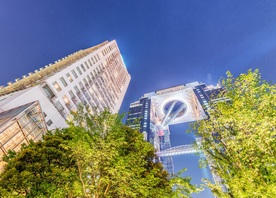A new permanent installation by Japan’s teamLab Borderless has turned Ibaraki’s rice terraces into art.

Intro
Japan’s innovative and award-winning art collective, teamLab Borderless, is back with a new ‘after-dark’ installation that brings together digital art and technology with the country’s rich agricultural heritage and natural beauty. Entitled, teamLab: Hidden Traces of Rice Terraces, and open only at night, this interactive exhibition transforms the ancient and submerged rice terraces of Izura, Ibaraki Prefecture, into a fusion of immersive digital art and nature, with unique illuminations, mirrors, LED lights, sounds, colours, and more. It’s as beautiful as it is imagination and a true synthesis of Japan’s technological and creative genius with the country’s nature and heritage. Let’s take a closer look and find out how to visit this extraordinary new installation using your JR Pass for unlimited travel on Japan’s rail network. 
Hidden Traces of Rice Terraces
Where better to start than the beginning, and who better to describe the intentions behind this new work than teamLab Borderless themselves? Here is their official quote: “In Izura, where the modern Japanese scholar and art critic Okakura Tenshin lived in his later years, there was a mountain along the coast that was difficult to enter. Coming out of the deep mountain forest there was a valley. There were remains of rain-fed rice terraces, now a marshland covered in reeds. They looked like secret rice terraces. Thinking about the long existence of nature and human activity continuing together, we decided to create artworks of the remains of the rice field terraces hidden in the forest. Then, walking around the forest covering the ruins of the rice terraces and surveying the vegetation, we thought to make the entire forest covering the ruins of the rice terraces into an artwork space that is at one with the surrounding plants.
“teamLab's project, Digitized Nature, explores how nature can become art. The concept of the project is that non-material digital technology can turn nature into art without harming it. The artworks explore how the existence of these forms can be used as they are to create a place where we can transcend the boundary in our understanding of the continuity of time and feel the long, long continuity of life. Using these existences that embody long periods of time as they are, we can experiment with transcending the boundary in our understanding of the long continuity of time and even today continue to accumulate meaning in this place.”
Here is a list of the different artworks at teamLan: Hidden Traces of Rice Terraces for you to discover after-dark:
- Water Mirror Path Through the Hidden Rice Terraces
- Resonating Universe in the Tabunoki Tree
- Cut Out Continuous Life
- Flowers Bloom When The Waves Rise - Sea of Izura
- Traces of Continuous Life
- Resonating Secret Valley and Forest
- Concrete and Abstract
- Cognitive Solidified Spark
- Reversible Rotation in the Forest
- Bamboo Forest of the Secret Valley
If this all sounds incredible - and it does - then just wait until you see how these artworks look. It’s yet another visually stunning creation from the visionaries at teamLab and well worth travelling to Japan to see for yourself. teamLab: Hidden Traces of Rice Terraces officially opened in September and is open from 6pm-10pm each day. From October 26-31, the opening hours shift to 5:30pm-10pm. It’s also closed on the first Tuesday of the month. For more information and ticket prices, visit teamLab’s official website.
To reach the new exhibition by train from Tokyo, get off at Isohara Station on the JR Joban Line Limited Express. It’s then 15 minutes by taxi. Alternatively, from Sendai, stop at Nakoso Station on the JR Joban Line Limited Express, and then jump in a taxi for 11 minutes to reach the installation. Finally, the nearest station is Otsuko Station on the JR Joban Line, which is just five minutes by taxi. However, please note that the JR Joban Line Limited Express trains do not stop at Otsuko Station.

What is teamLab Borderless?
In short, teamLab Borderless is a Japanese-based art collective of ‘ultra-technologists’ made up of artists, animators, mathematicians, engineers, programmers, designers, botanists, and architects. However, perhaps the best description comes from the group’s own website: “teamLab Borderless is a world of artworks without boundaries, a museum without a map created by art collective teamLab. Artworks move out of rooms, relate to other works, influence each other, and at times intermingle, without boundaries. Through this group of works, one continuous world without boundaries is created. Immerse your body in borderless art. Wander, explore with intention, discover, and create a world with others. 
Founded in 2001, teamLab exhibitions have been held in cities worldwide, including New York, London, Paris, Singapore, Silicon Valley, Beijing, and Melbourne among others. teamLab museums and large-scale permanent exhibitions include teamLab Borderless and teamLab Planets in Tokyo, teamLab Borderless Shanghai, and teamLab SuperNature Macao, with more to open in cities including Abu Dhabi, Beijing, Hamburg, Jeddah, and Utrecht. teamLab’s works are in the permanent collection of the Museum of Contemporary Art, Los Angeles; Art Gallery of New South Wales, Sydney; Art Gallery of South Australia, Adelaide; Asian Art Museum, San Francisco; Asia Society Museum, New York; Borusan Contemporary Art Collection, Istanbul; National Gallery of Victoria, Melbourne; and Amos Rex, Helsinki.”
Incredibly, teamLab won a Guinness World Record as the most visited museum dedicated to a single group or artist in the world with 2.3 million visitors in its first year of opening. The group’s installations have continued to prove hugely popular ever since, right up to the launch of their latest museum in Tokyo, which opened in February 2024.

Japan’s Historic Rice Terraces
As well as being a stunning work of contemporary art, teamLab’s latest installation also puts the spotlight on Japan’s special relationship with rice. Rice has played an essential part in Japan’s culture and history for more than 2,000 years. As such, there are few better ways to experience ancient Japan than by visiting its rice terraces, fields and paddies (known as ‘Tanada’) for yourself. You’ll regularly see the words ‘tanada’ and ‘senmaida’ used to describe rice fields. Tanada refers to ‘terraced paddies’ while Senmaida means ‘a thousand terraced paddies’. Rice planting is always done in Spring or early Summer and harvesting takes place in Autumn. Japanese rice is a round grain variety and exists in two general and distinct forms – koshihikari and sasanishiki – which are grown and cultivated in different parts of Japan. The variety with longer grains is used for sushi. Alongside the rice terraces in Izura, Ibaraki prefecture, there are many more beautiful and historic locations to visit while in Japan such as:
- Shiroyone Senmaida
Famous for its 1,000 rice field terraces that descend to the sea, Shiroyone Senmaida is an incredibly beautiful and picturesque spot to behold, and location to explore. Shiroyone Senmaida was awarded a special status by the Food and Agriculture Organization of the United Nations for being a place of such scenic beauty. Between April and July, you can see beautiful sunsets, green fields, and stunning reflections in the sea and flooded paddies. In autumn, it is known for its amazing golden colours. And at night, the terraces are illuminated by 21,000 LED lights. The wider area is known for being excellent for walking, hiking and cycling too. Like many of Japan’s stunning rice field terraces, Shiroyone Senmaida attracts huge numbers of photographers. It’s highly Instagrammable (in the parlance of our times) and it would also make a very romantic marriage proposal location if you’re thinking of saying Marry Me! to your partner. To visit this famous location, take the Hokutetsu Okunoto local bus on the ‘Machino-sen’ line from JR Wajima train station and get off at the bus stop marked ‘Shiroyone’.
- Hoshitoge Rice Terraces
Located in Niigata Prefecture, Hoshitoge no Tanada is regarded as one of Japan’s most beautiful villages and rice terraces. Its fields, featuring more than 200 terraces, are arguably the prettiest in all of Japan, especially when the mist rolls in over the water-filled paddies in Autumn. To reach Hoshitoge no Tanada with a Japan Rail Pass, take the Shinkansen from Tokyo Station to Echigo-Yuzawa Station, transfer to the Hokuhoku Line in the direction of Saigata and disembark at Matsudai.

Bonus recommendations
- teamLab Borderless has been busy this year. As well as this latest permanent installation, they opened a new digital art museum at Azabudai Hills - a modern urban village complex of skyscrapers - in Central Tokyo. This is the new permanent home for teamLab Borderless following the closure of their previous museum in Odaiba and you can read all about it in our article, Japan’s teamLab Borderless Return to Tokyo.
- For more on Japan’s rice cultivation read our guide to Japan’s Historic and Beautiful Rice Fields.
- Alongside teamLab, Japan has lots to offer lovers of art and culture, from leading museums and galleries to an island dedicated to outdoor art and more. Read about the Miho Museum in Shiga, the Edo Tokyo Museum, or plan a visit to Naoshima Art Island with the JR Pass.
- Want to upload your photos of any stunning artworks you see in Japan onto your social media? To stay connected to the internet we highly recommend investing in a PocketWifi device for constant internet access and high speed unlimited data.
- If your visit to see teamLab Borderless’ latest work is your first time in the country, why not make life easier by using our Meet & Greet service on arrival? It’s like having an expert on Japan as your personal assistant. We’ll take care of you from the moment you arrive.
.jpg)




